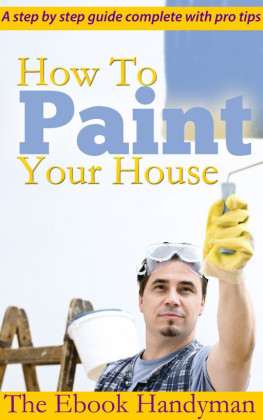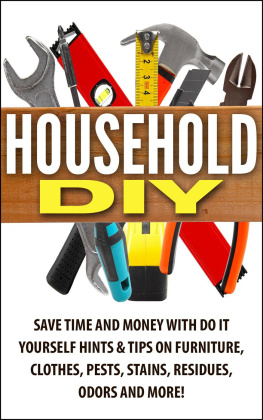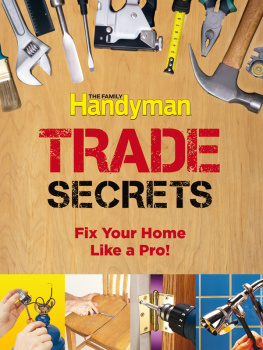A Note to Our Readers
All do-it-yourself activities involve a degree of risk. Skills, materials, tools and site conditions vary widely. Although the editors have made every effort to ensure accuracy, the reader remains responsible for the selection and use of tools, materials and methods. Always obey local codes and laws, follow manufacturer instructions and observe safety precautions.
Pricing
Professional services and supplies can vary widely depending on the market. Those listed are average costs and are just a guide to cost savings.
Do-It Yourself Basics
Content Management, Design and Page Layout Elizabeth Tunnicliffe
Proofreader Judy Arginteanu
Text, photography and illustrations for Do-It Yourself Basics are based on articles previously published in The Family Handyman magazine (2915 Commers Dr., Suite 700, Eagan, MN 55121, familyhandyman.com). For information on advertising in The Family Handyman magazine, call (646) 518-4231.
Do-It Yourself Basics is published by Trusted Media Brands, Inc. 2017 All rights reserved. This volume may not be reproduced in whole or in part without written permission from the publisher. The Family Handyman and Readers Digest are registered trademarks of Trusted Media Brands, Inc.
Family Handyman ISBN: 978-1-62145-353-6
Readers Digest ISBN: 978-1-62145-375-8
eISBN: 978-1-62145-354-3
Address any comments to:
The Family Handyman
Editor in Chief Gary Wentz
Senior Editor Travis Larson
Associate and Contributing Editors Mary Flanagan, Jeff Gorton, Mark Petersen, Jason White
Digital Content Editor Andrew Zoeliner
Managing Editor Donna Bierbach
Contributing Copy Editor Peggy Parker
Art Directors Vern Johnson, Marcia Roepke
Production Artist Mary Schwender
Photographer Tom Fenenga
Contributing Editors Elisa Bernick, Spike Carlsen, Ken Collier, Rick Muscoplat, David Radtke
Lead Carpenter Josh Risberg
Editorial Services Associate Peggy McDermott
Trusted Media Brands, Inc.
President & Chief Executive Officer Bonnie Kintzer
Safety firstalways!
Tackling home improvement projects and repairs can be endlessly rewarding. But as most of us know, with the rewards come risks. The good news is, armed with the right knowledge, tools and procedures, homeowners can minimize risk. As you go about your projects and repairs, stay alert for these hazards:
Aluminum wiring
Aluminum wiring, installed in about 7 million homes between 1965 and 1973, requires special techniques and materials to make safe connections. This wiring is dull gray, not the dull orange characteristic of copper. Hire a licensed electrician certified to work with it. For more information go to cpsc.gov and search for aluminum wiring.
Spontaneous combustion
Rags saturated with oil finishes like Danish oil and linseed oil, and oil-based paints and stains can spontaneously combust if left bunched up. Always dry them outdoors, spread out loosely. When the oil has thoroughly dried, you can safely throw them in the trash.
Vision and hearing protection
Safety glasses or goggles should be worn whenever youre working on DIY projects that involve chemicals, dust and anything that could shatter or chip off and hit your eye. Sounds louder than 80 decibels (dB) are considered potentially dangerous. Sound levels from a lawn mower can be 90 dB, and shop tools and chain saws can be 90 to 100 dB.
Lead paint
If your home was built before 1979, it may contain lead paint, which is a serious health hazard, especially for children 6 and under. Take precautions when you scrape or remove it. Contact your public health department for detailed safety information or call (800) 424-LEAD (5323) to receive an information pamphlet. Or visit epa.gov/lead.
Buried utilities
A few days before you dig in your yard, have your underground water, gas and electrical lines marked. Just call 811 or go to call811.com.
Smoke and carbon monoxide (CO) alarms
The risk of dying in reported home structure fires is cut in half in homes with working smoke alarms. Test your smoke alarms every month, replace batteries as necessary and replace units that are more than 10 years old. As you make your home more energy-efficient and airtight, existing ducts and chimneys cant always successfully vent combustion gases, including potentially deadly carbon monoxide (CO). Install a UL-listed CO detector, and test your CO and smoke alarms at the same time.
Five-gallon buckets and window covering cords
From 1996 to 1999, 58 children under age 5 drowned in 5-gallon buckets. Always store them upside down and store ones containing liquid with the covers securely snapped.
According to Parents for Window Blind Safety, 599 children have been seriously injured or killed in the United States since 1986 after becoming entangled in looped window treatment cords. For more information, visit pfwbs.org or cpsc.gov.
Working up high
If you have to get up on your roof to do a repair or installation, always install roof brackets and wear a roof harness.
Asbestos
Texture sprayed on ceilings before 1978, adhesives and tiles for vinyl and asphalt floors before 1980, and vermiculite insulation (with gray granules) all may contain asbestos. Other building materials, made between 1940 and 1980, could also contain asbestos. If you suspect that materials youre removing or working around contain asbestos, contact your health department or visit epa.gov/asbestos for information.
For additional information about home safety, visit mysafehome.org. This site offers helpful information about dozens of home safety issues.
Contents
Master the hammer
Which weight? A 16-oz. hammer is right for most jobs. Avoid hammers with a jagged waffle texture on the striking face. When you miss a nail, they do ugly things to surfacesor your thumb.
Style The basic household hammer is a curved claw but consider a versatile rip claw. When swung backwards it can dig holes, split wood and help break up stuff.

NAIL SET
Nailing Grip hammer near the end, lightly but firmly. Keeping wrist straight, let the hammer fall naturally, aided by shoulder and upper arm. Hammer the nail to within 1/8 in. of surface; countersink the head with nail set. To use a nail set, position its point over the head of the nail and strike the top with a hammer. Fill the hole with wood putty. (A nail set is a punch-shaped tool designed to sink, or set, nails beneath the surface of the wood.)
Pull sideways The usual way to pull a nail is to lever the claw straight up. But when a nail wont budge, yank the handle to the side. That puts the pivot point closer to the nail for more pulling power.
Pull against a block A small block under the claw does two things: It protects the surface beneath it and provides more pulling power, especially after the nail is partially removed.
pro tips!
Holding a small nail or brad when you start is difficult. Stick the nail through one end of a folded sheet of stiff paper. Using the paper as a holder, drive in the nail. Then before seating, tear the paper away.
CAUTION: Wear goggles; a miss-hit can send a nail flying.
Drive screws like a pro
Style A screwdriver should have a comfortable nonslip handle and a crisply machined blade tip.








